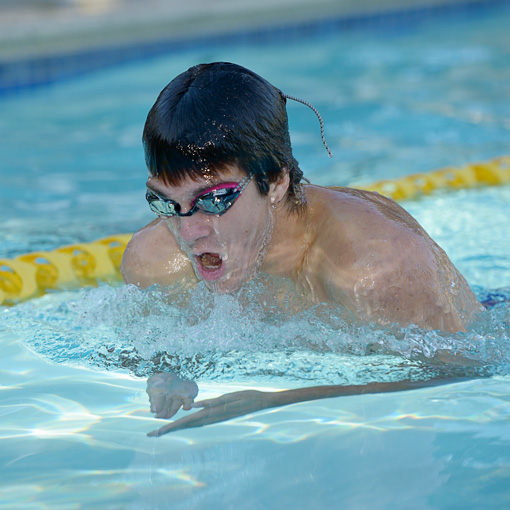BREASTSTROKE TIPS
Breaststroke is quite the odd stroke…maybe that’s why Coach Ryan is so good at it! It’s an unusual combination of power and finesse, and the only swimming stroke where you kick your legs out and around, instead of up and down.
- ARMS: Breaststroke arms are tight little circles, and your hands should never leave your sight. Don’t just “smear” the water—keep your elbows high and take real, strong pulls.
- KICK: Up, Out, Together! Think about bending your leg from the knees down and bring your heels up to try and kick your bottom. Sweep your legs around quickly and snap your ankles together as you finish your kick.
- BREATHING: Take your breath right after your glide, while your hands are grabbing the water and pulling it toward you. Stay as low as possible to conserve energy.
- TIMING IS EVERYTHING: Pull, Breathe, Kick, Glide. These steps overlap, so that while you are moving your arms you start to breathe, and while you’re breathing you start your kick. Everything finishes in a near-streamline position for the glide.
- POWER: You should take a big strong pull with a quick breath, and then a snappy kick that helps your hands shoot forward into a nice pointy glide.

Official Rules for Breaststroke
ARMS:
- Both arms must mirror each other, moving at the same time, in the same motion, at the same depth
- Your arms cannot move past the hip line except during the pulldown phase (see below)
- Your elbows cannot come out of the water as the arms return to start the next pull
KICK:
- Your legs must mirror each other, moving at the same time in the same motion
- Your feet must be turned outward during the sweep of the legs
- Alternating, butterfly, or scissor kicks are not allowed
CYCLE:
- The stroke cycle must be one arm pull and one leg kick, in that order
- Your head must break the surface of the water at some point during each stroke cycle
PULLDOWN:
- At the start and after each turn, a single pulldown is permitted
- During the pulldown, you may take one arm stroke past the hips and down to the legs
- Your head must break the surface before the hands turn inward on the second stroke
FINISH:
- You must touch with two hands at the same time
Breaststroke Drills
2-Kick or 3-Kick
- Description: Normal cycles of breaststroke (pull and breathe, kick, glide) have extra kick(s) between pulls.
- Purpose: The proper glide point in breaststroke is after the kick, before the next pull, with the hands extended in front. Most timing problems in breaststroke stem from having the wrong glide point. This drill emphasizes the proper glide point by having the swimmer stop pulling and do additional kicks.
Whistle Drill
- Description: Push off the wall and glide in a streamline position. When the coach blows the whistle, take a complete stroke (pull, breathe, kick) and return to the glide position until you hear another whistle.
- Purpose: This is another drill that reinforces the correct stroke cycle and glide point.
Pulldown Drill
- Description: After three normal strokes, go through a complete pulldown sequence. Repeat the cycle.
- Purpose: This drill is added practice for the pulldown.
Breaststroke Arms with Dolphin Kick
- Description: While swimming normal breaststroke, do dolphin kick rather than breaststroke kick.
- Purpose: Breaststroke and butterfly are both short-axis strokes, meaning that you bend in the middle of the body (in contrast to freestyle and backstroke, where you pivot around the long axis through your body from head to toe). Since breaststroke and butterfly have similar movements, you can use dolphin kick to emphasize the undulation in breaststroke. As you kick into your glide, get you hips up and push your chest down to press your hands out further.
Breaststroke Arms with Freestyle Kick
- Description: Do regular breaststroke, but use freestyle kick rather than breaststroke kick.
- Purpose: For many young swimmers, freestyle kick is more natural than breaststroke kick. This drill allows you to focus on the arms and breathing while keeping your legs up with a more instinctive flutter kick.
Breaststroke with Noodles
- Description: Do regular breaststroke with a noodle under your arms. This can be done with your head out of the water (to focus on the arm cycles only) or while breathing normally (to emphasize the relationship between the arms and breathing).
- Purpose: There are several reasons this is a great drill for young swimmers. First, the noodle provides a weak barrier to help your arms stay “in front” rather than pulling down to the hips, which is cause for a DQ. Second, the noodle helps you stay on top of the water, since staying afloat can be a struggle for young kids. Third, everyone loves noodles!